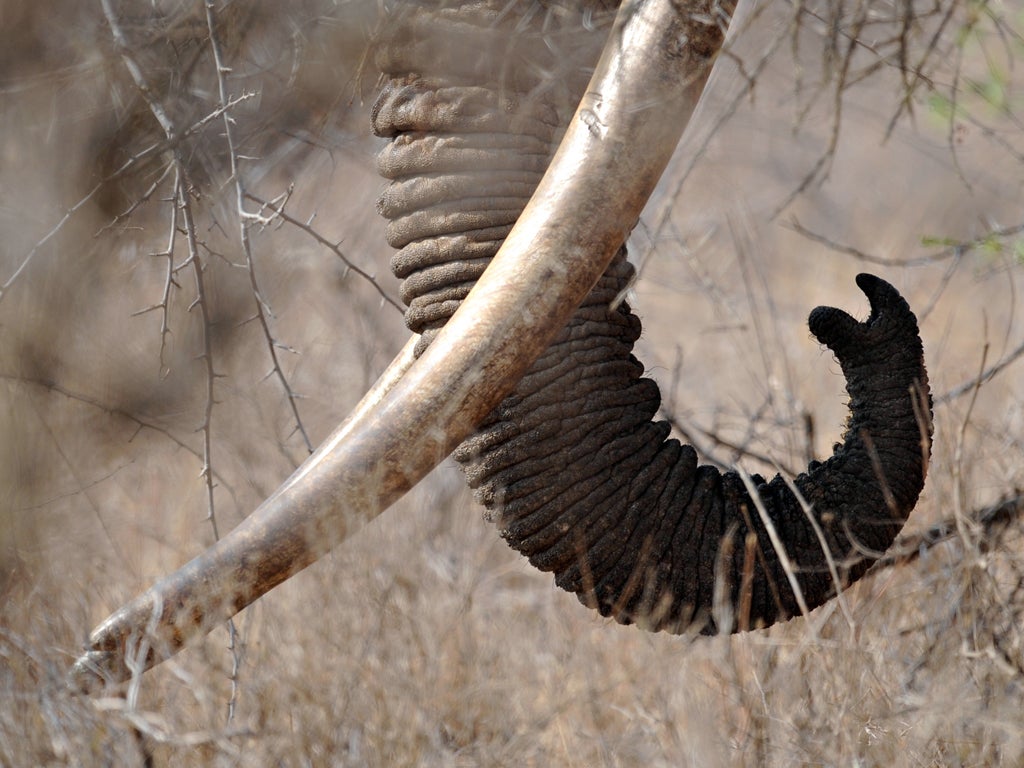Time is running out fast for Tanzania’s elephant herds
With poachers now killing almost 11,000 a year for their ivory, urgent steps need to be be taken to stop the cull

Just 8km from a tourist camp in Tanzania's largest national park, poachers armed with AK-47s slaughtered two elephants and removed their tusks with chainsaws.
Welcome to the next front line in the poaching war. Ruaha ecosystem covers almost four million hectares in south-western Tanzania and is one of the last strongholds of the elephant.
Tanzania's elephant population declined from an estimated 109,000 elephants in 2009 to around 70,000 in 2012, according to the Tanzania Elephant Protection Society. Around 30 elephants are killed for their ivory every day, almost 11,000 each year.
It is estimated that Tanzania has lost half its elephant population since 2007 and it is thought it could be wiped out entirely in just seven years.
Here in Ruaha, the slaughter is increasing at a worrying rate. In November, three more elephants were killed. Poachers shot two large bull elephants, while a female was found just a kilometre from another tourist lodge, where she had walked before she fell, dying from her wounds. Elephants are now being killed at an estimated rate of one a week inside the national park, according to officials. In the surrounding area, it could be four times as many.
But everyone knows it could get much worse. Selous Game Reserve - which I passed through on my way to Ruaha - is another popular tourist destination in southern Tanzania turned into vast killing fields. The 21,000 square mile wilderness has lost more than 80 per cent of its elephants to poaching in the last six years. In 2007, it had an estimated 50,000 elephants. A recent census, undertaken by Tanzanian wildlife authorities with support from Frankfurt Zoological Society showed just 13,084 elephants are left.
Mary Sandifer, manager of Mdonya Old River Camp in Ruaha National Park, said: “People must be made aware of the problem. It isn't going to go away unless action is taken all over the world.”
An elephant census has been undertaken in Ruaha, but figures have not yet been released. But Godwell Meing'ataki, former acting chief park warden and now project co-ordinator for the Spanest Project (Strengthening the Protected Area Network in Southern Tanzania), which paid for the census, warns that the previously intact ecosystem could be the next target.
“Ruaha is the next front line [for poachers],” predicted Meing'ataki. “The Ruaha ecosystem used to be the second stronghold of elephant populations in Tanzania, but now we think it is the first, given what has happened to the Selous. There is increasing security in the park, but when elephants go out of it, there is little protecting them.”
But things nationwide are not clear-cut. The anti-poaching initiative Operation Tokomeza, launched by Tanzania's President Jakaya Kikwete last year, made national headlines for its reported shoot-to-kill orders and sweeping arrests to deal with poachers.
The short-lived operation - which reportedly claimed the lives of 13 civilians - was suspended following reports of human rights abuses, including the seizure of property, torture, rape and murder of innocent people. Four Tanzanian ministers were forced to resign just weeks ago for mishandling the operation - including the Minister of Natural Resources and Tourism.
Yet, I am told by security in Ruaha National Park that they are stepping up their anti-poaching programme. “We are doing patrols and intelligence gathering,” said a member of the Park's protection team, who did not want to be named. “It's syndicates organising this; we expect them to move this way. If we don't [do something], this is going to get much worse in the next three years. These people are using weapons and are intimidating. It could affect our tourism.”
A little over 120 rangers patrol an area of almost 22,000 square km, but authorities are investing in specialist anti-poaching skills, training for staff and are working with local communities to strengthen their intelligence gathering services. The Spanest Project, funded by UNDP and the Global Environment Facility, is working with the park to provide digital communication systems for the park and rangers, provide vehicles, specialist ranger training and enhanced intelligence systems. They also plan to support a co-ordinated national response for all ecosystems in Tanzania, working with government and other donors.
Space for Giants the charity determined to protect Africa's elephants, aims to support the rapid response capacity, developed in Laikipia, into southern Tanzania, in collaboration with local partners and the government. It also hopes to transfer its work with the judiciary in Kenya to Tanzania - to deter poachers in the first place.
Join our commenting forum
Join thought-provoking conversations, follow other Independent readers and see their replies
Comments
Bookmark popover
Removed from bookmarks